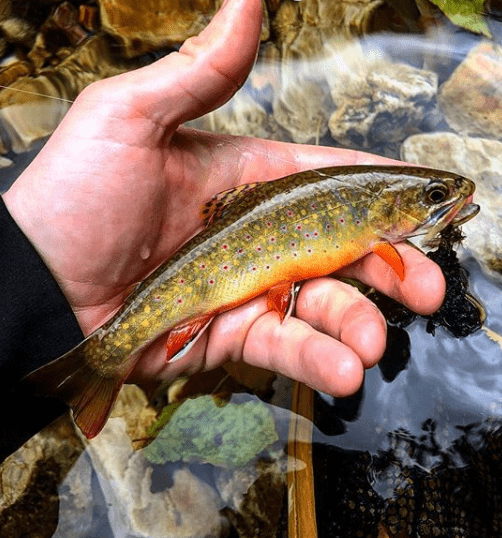Where to catch Native Brook Trout and how to find them.
You can catch native Brook Trout in the Appalachian region of Maryland, Virginia, West Virginia, North Carolina, Tennessee, and Georgia.
Yes, Southern Native Brook Trout live in the mountains, but where in particular? Keep reading, and below we’re going to dive more in depth to help figure out the answer to that question.
Finding Native Brook Trout
Native Brookies live in abundance in cold water streams that roll off of mountains and wooded hills. The key when finding these fish is to look for cold and clean water. Brook Trout aren’t as hardy as largemouth bass. These are fragile fish that need excellent conditions to survive.
You can find these clean, cold water streams by locating moving water that is coming off of mountains that have adequate shade cover.
Be weary of streams that lead from ponds or small lakes. Those could be too warm and would not sustain a Brook Trout population. Especially if you’re located in the deep south. If you want to be sure then you could take a temperature reading of the water leaving the lake. Anything over 68 means no Brook Trout will be present.
Checking out google maps or google earth can be a great way to find find streams that are on public land. Locate national parks, or forests and from there you can check out smaller river and creek systems that work their way off of the mountains. The overhead view also gives you a good idea of the canopy cover on the river.
Gear for Catching Native Brook Trout
When you’re fishing these mountain streams you’ll typically be in tight quarters. There are going to be a lot of bushes, branches, and boulders getting in the way of your cast.
Which is why a shorter rod will work best. Taking a 9′ rod or longer into these situations can make for tough fishing. If you do this then you should get comfortable with the bow and arrow, or roll cast. Anything shorter is ideal, but an 8′ or a 7′ 6″ rod is going to be perfect. A shorter rod is going to help you catch native Brook Trout.
This will allow you to cast more comfortably without getting you’re fly hung up on surrounding branches.
If you’re doing a lot nymphing or using other wet flies then you could get away with a 8′ 6″.
If you plan on wading the river then a pair of hiking boots or solid wading boots are going to be you’re best friend. Most of the time there is a lot of hiking involved when fishing these mountain streams. A reliable and comfortable pair of footwear will be key.
Wet wading these streams can be great in the summer when the air temperature reaches 90 degrees but the water remains cool. A pair of waders can be great during the early spring when the air temperature is still cool.
Fly’s Needed
Brook Trout are one of the most aggressive game fish an angler can attempt to catch. Even during cold months when no hatches are present you could still go and catch these fish on dry flies. It may not be a very successful day, but if its February and you’re itching for some dry fly action then heading to the mountains might not be a bad way to scratch that itch.
Two of the most popular dry flies you can use for these fish are an elk hair caddis and a Parachute Adams. Start with a Caddis and then work to the Adams. If neither of these work then go subsurface.
Try out some smaller wet flies that resemble the smaller bait fish. A Wooly Bugger is always a great option to catch native Brook Trout.
For nymphs, a beadhead pheasant tail is hard to beat. In the summer when the terrestrials are out try dropping a sinking ant underneath underneath a beetle.
Conclusion
Hiking far off from the road to what looks like a good Brook Trout stream on a map does not always produce. Sometimes you think you’ve found the perfect river, but it leads to a day of disappointment. Then other times you take a risk on a stream and it pays off big time.
This is the risk and reward that you’re playing with when picking off streams from a map and determining if they’re holding fish or not. There is no guarantee that you’re going to catch anything. However, there is a great reward that comes from picking the stream from a map and making it happen.



